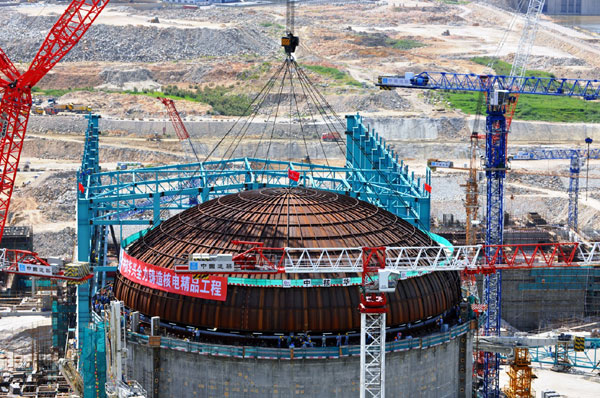Nuclear program will bring more power
Updated: 2012-12-24 07:39
By Jiang Xueqing reports from Shenzhen and Wu Wencong from Beijing (China Daily)
|
|||||||||||
In addition to upgrading nuclear safety standards, the nation will also boost the technological advancement of key equipment, such as Generation III reactors, and widen the application of the latest equipment, as required by China's Energy Policy 2012.
"The government raised a specific target for probabilistic risk assessment of nuclear power reactor units to be built from 2016-20 and afterwards," said Chen Xiaoqiu, deputy chief engineer of the Nuclear and Radiation Safety Center under the Ministry of Environmental Protection.
"It required that the core-damage frequency (a term used in probabilistic risk assessment indicating the likelihood of an accident that could damage a nuclear reactor core) of these newly constructed units should be less than 1x105, meaning that one core damage incident is likely to take place in 100,000 reactor years. The large release frequency, indicating the likelihood of an accident causing a massive discharge of radioactive materials into the environment, should be less than 1x106 per reactor year, meaning one large release incident is likely to occur in 1 million reactor years," he said.
Previously, the core-damage frequency and large-release frequency deemed acceptable for reactors were both 10 times higher, meaning China had lower safety standards in the past.
Advanced technology
But now, it has adopted some of the world's most advanced third-generation pressurized water reactors such as the AP1000 and EPR. The core-damage frequency of an AP1000 reactor is 5x107 per year, and the large-release frequency is 6x108 per year. The figures mean that for this type of reactor one core-damage incident is likely to happen in 2 million reactor years, and one large-release incident in 16.67 million reactor years.
Both the Zhejiang Sanmen Nuclear Power Project and Shandong Haiyang Nuclear Power Project have two AP1000 nuclear power reactors under construction, while the Guangdong Taishan Nuclear Power Plant is building two EPR units, said Chen.
 |
|
Work on the main roof structure of No 2 generating unit in Guangdong Taishan Nuclear Power Plant was completed on Sept 12. Wang Pan / Xinhua |
China has also made breakthroughs in the research and development of high-temperature gas-cooled reactors and advanced large pressurized water reactors. The country's indigenous 3G nuclear power technologies include the ACP1000, developed by China National Nuclear Corp, the ACPR1000+ from China Guangdong Nuclear Power Holding Co, and the CAP1400 by the State Nuclear Power Technology Corp.
Related Stories
Shandong gets permit to build nuclear plant 2012-12-14 16:34
Nuclear power developer waiting for IPO approval 2012-12-10 21:41
Tokyo raises nuclear fears 2012-12-08 10:09
Nuclear power a key issue in Japan polls 2012-12-03 07:44
Official projects China's 2015 nuclear power 2012-11-29 09:36
Today's Top News
President Xi confident in recovery from quake
H7N9 update: 104 cases, 21 deaths
Telecom workers restore links
Coal mine blast kills 18 in Jilin
Intl scholarship puts China on the map
More bird flu patients discharged
Gold loses sheen, but still a safe bet
US 'turns blind eye to human rights'
Hot Topics
Lunar probe , China growth forecasts, Emission rules get tougher, China seen through 'colored lens', International board,
Editor's Picks

|

|

|

|

|

|





